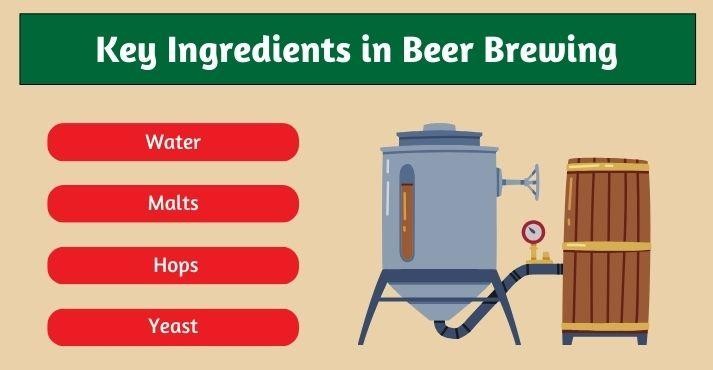Brewing beer at home has become more than just a hobby; it’s a passion for enthusiasts worldwide. The art of crafting your beer allows for unlimited creativity, enabling you to experiment with flavors, ingredients, and brewing techniques.
This allows you to explore what beer is made of and gives you control over the entire process, from selecting the finest malts and hops to deciding carbonation levels.
For many, learning how to brew beer offers an exciting way to save money while indulging in a hands-on activity that yields rewarding results.
Beyond its financial and creative aspects, home brewing introduces people to the fascinating science behind fermentation and carbonation. It’s a journey where patience and attention to detail culminate in a personalized brew that rivals commercial options.
This guide will reveal every detail about beer preparation, from gathering equipment to bottling your creations. Whether you want to learn how long it takes to make beer or are ready to make it at home, this article is your ultimate companion to crafting exceptional brews.
What Is Beer Brewing?
At its core, beer brewing is a centuries-old process transforming raw ingredients into the beloved beverage enjoyed worldwide today. But what exactly does the brewing process entail?
The journey begins with four key ingredients: water, malt, hops, and yeast. These are carefully combined in steps, including mashing, boiling, fermenting, and carbonation.
While these steps sound straightforward, the art of brewing lies in precision and attention to detail. Even slight variations in temperature or timing can significantly impact the flavor and quality of the beer.
Brewing isn’t just about science; it’s also a creative craft. Homebrewers can tailor recipes to match their preferences, whether they crave a hoppy IPA or a malty stout.
Comprehending the process of brewing beer helps enthusiasts make informed decisions at every stage, ensuring their creations are flavorful and well-balanced.
Key Ingredients in Beer Brewing

Every successful beer begins with a deep understanding of its ingredients. Each component; water, malt, hops, and yeast—uniquely shapes the final brew.
1. Water
Water’s quality directly influences the beer’s taste as the primary ingredient. Different regions like Singapore or Southeast Asia are known for water profiles that boost specific beer styles.
Hard water, rich in minerals, is ideal for robust stouts, while soft water suits crisp lagers. Aspiring brewers who want to make their beer often invest in water testing or filtration systems to achieve the perfect base.
2. Malts
Malts provide the sugars needed for fermentation. Barley is the most common grain, but wheat, rye, and oats are also popular in specialty beers.
Different malts contribute unique flavors, ranging from sweet and biscuity to deep and roasted. For those curious about brewing beer, experimenting with malt combinations is an exciting way to personalize flavors.
3. Hops
Hops add bitterness to balance the malt’s sweetness and impart complex flavors. Varieties like Cascade bring citrusy notes, while Noble hops offer floral and herbal aromas.
Hops also have preservative qualities, making them indispensable in beer brewing. Whether you’re crafting a classic Pilsner or a tropical IPA, hops are crucial.
4. Yeast
Yeast is what makes beer alcoholic. Ale yeasts work at higher temperatures, producing fruity esters, while lager yeasts ferment slowly, resulting in clean, crisp flavors. Understanding yeast’s workings is key for anyone learning to make beer, as it significantly impacts the beer’s style and character.
Essential Equipment for Homebrewing
When starting your home brewing journey, having the right equipment is just as important as the ingredients. The tools you use determine the efficiency of your brewing process and the quality of the final product.
When you’re a beginner learning the basics or an experienced brewer exploring advanced techniques, assembling a reliable brewing setup is the first step toward success.
Basic Equipment List
To make beer at home, you’ll need some essential tools that form the foundation of your brewing setup. These items are indispensable for both beginners and seasoned brewers:
- Fermenter: A fermenter is a container where your beer undergoes fermentation. It can be a food-grade plastic bucket, glass carboy, or stainless steel tank. Fermenters should have an airtight seal to prevent contamination and allow the beer to develop properly.
- Airlock: The airlock is a small but crucial device. It allows carbon dioxide produced during fermentation to escape, preventing air and bacteria from entering. This ensures your beer remains uncontaminated during the critical fermentation phase.
- Thermometer: Temperature control is vital in beer brewing, especially during mashing and fermentation. A high-quality thermometer helps you monitor temperatures to maintain consistency.
- Hydrometer: This tool measures the sugar content in your beer, allowing you to track fermentation progress and calculate the alcohol content. It’s an essential device for anyone learning how to brew beer with precision.
- Siphon: A siphon makes transferring beer easily from one container to another without disturbing the sediment. This tool helps ensure clarity in your beer while maintaining cleanliness.
- Bottles and Caps: Once your beer is ready, you’ll need bottles to store it. Glass bottles are a popular choice, and caps ensure a secure seal for carbonation. Bottle cappers make sealing more efficient.
Investing in these tools will set you up for success in beer preparation and help you avoid common mistakes in your brewing journey.
Cost-Effective Starter Kits
Starter kits are an excellent option for those just beginning to explore beer-making. These kits simplify the process by providing all the basic tools and ingredients in one package. Brands like Coopers and BrewSmith, widely available in Singapore, cater specifically to beginners.
Starter kits often include a fermenter, airlock, sanitizer, brewing ingredients, and detailed instructions. They remove much of the guesswork, allowing you to focus on the fundamentals of brewing.
Many beginners find these kits a cost-effective way to learn the ropes without significant investments in advanced equipment.
Using your home brewing journey as a starter kit, you can quickly start your journey in home brewing and gain hands-on experience. Once confident, you can explore more complex methods and upgrade your equipment.
Advanced Equipment for Enthusiasts
As you gain experience, upgrading your brewing setup becomes a logical next step. Advanced equipment aligns the process and enables you to craft more complex and refined beers.
- Grain Mills: Crushing your malted grains at home ensures fresher flavors and allows you to experiment with different grain combinations. This is an excellent upgrade for brewers interested in creating unique beers.
- Wort Chillers: Cooling the beer wort quickly after boiling is critical to prevent bacterial contamination. Wort chillers, whether immersion or counterflow types, significantly reduce cooling time and help maintain the beer’s quality.
- Kegging Systems: Kegging systems are an excellent investment for those looking for convenience and a professional touch. They allow you to store your beer in kegs instead of bottles, making serving easier while preserving freshness.
Advanced equipment allows for creating complex beer styles, such as barrel-aged stouts, double IPAs, and fruit-infused ales. It also improves the brewing experience, providing greater control over every aspect of the process.
Step-by-Step Guide: How to Brew Beer at Home

Brewing beer may seem daunting initially, but anyone can create delicious homebrews with the proper steps.
Brewing beer at home is a rewarding process that combines science and creativity. It turns basic ingredients into flavorful, personalized brews. Follow this detailed guide to master how to brew beer at home, from preparation to the final bottling.
1. Preparation
Preparation is the cornerstone of successful beer preparation. Before diving into the brewing process, ensure you’re equipped with sanitized tools and precisely measured ingredients. Cleanliness and precision at this stage can make or break your beer’s quality.
- Sanitizing Equipment: Contamination is one of the biggest risks in beer brewing. Bacteria or wild yeast can spoil your brew, leading to off-flavors or even rendering the beer undrinkable. Use a no-rinse sanitizer like Star San to thoroughly clean your fermenter, airlock, spoons, bottles, and any other equipment that will come into contact with your beer.
- Measuring Ingredients: Accuracy matters when deciding the ratios of malt, hops, yeast, and water. Even a slight imbalance can alter your beer’s flavor or texture. Follow your recipe closely and use digital scales and measuring tools for consistency.
Proper preparation ensures a smooth brewing process and lays the foundation for a flavorful, well-balanced beer.
2. The Brewing Process
The brewing process transforms raw ingredients into wort, the unfermented liquid that will become beer. This phase involves mashing, boiling, and cooling, each requiring attention to detail.
- Mashing: Begin by steeping your malted grains in hot water (typically around 150 degrees Fahrenheit or 65 degrees Celsius). This step extracts fermentable sugars from the grains, creating a sweet, sugary liquid called mash. Stir occasionally and maintain a consistent temperature to ensure maximum sugar extraction.
- Boiling: After mashing, the wort is separated from the grains and brought to a boil. During this phase, hops are added at specific intervals. Early additions contribute bitterness, while later ones boost flavor and aroma. Be mindful of timing, as it significantly affects the final taste.
- Cooling: Once the boiling is complete, the wort must be cooled quickly to a temperature suitable for fermentation, typically around 70 degrees Fahrenheit (21 degrees Celsius). Use a wort chiller or place your brew pot in an ice bath. Quick cooling prevents contamination and helps retain the beer’s flavor profile.
3. Fermentation
Fermentation is where the magic happens. Yeast is introduced to the cooled wort, which converts sugars into alcohol and carbonation.
- Pitching Yeast: Transfer your wort into the fermenter and add the yeast after cooling. Stir gently to mix, ensuring the yeast is evenly distributed.
- Temperature Control: Place the fermenter in a location with a stable temperature suited to the yeast type you’re using.
Monitor the fermentation process over the next one to two weeks. As carbon dioxide is released, you’ll notice bubbling in the airlock, a sign that the yeast is actively working.
4. Bottling and Carbonation
The final step in beer preparation is bottling and achieving the perfect carbonation level. This phase takes patience but is vital for a professional-quality brew.
- Priming Sugar: Before bottling, dissolve a precise amount of sugar in water and mix it into your beer. This sugar is fuel for natural carbonation, as the remaining yeast will consume it and release carbon dioxide.
- Sealing Bottles: Transfer the beer into clean, sanitized bottles and cap them securely. Make sure there’s no excess headspace to prevent oxidation.
- Storage and Aging: Store the bottles in a cool, dark place for at least two weeks. This allows the beer to carbonate fully and the flavors to mature. Patience during this stage will reward you with a better-tasting brew.
Common Brewing Mistakes and How to Avoid Them

Brewing beer is an enjoyable process, but it comes with a learning curve. Knowing and avoiding common mistakes can save you from costly errors and ensure your beer turns out as planned.
While some issues are minor, others can compromise the quality of your brew or even ruin an entire batch. Here are the most frequent pitfalls and tips to overcome them.
1. Under-Sanitizing Equipment
Proper sanitation is critical. Any contamination from unclean equipment can introduce bacteria, ruining your beer’s flavor and stability. Use specialized sanitizers like Star San to thoroughly clean fermenters, airlocks, and bottles.
2. Temperature Mismanagement
Fermentation temperature is key to yeast activity. If it’s too high, you risk off-flavors; the yeast may become inactive if it is too low. Invest in a thermometer and maintain a consistent range suitable for your yeast type, whether brewing an ale or lager.
3. Over-Carbonation
Adding too much priming sugar during bottling can lead to excessive carbonation, resulting in gushing beer or even bottle explosions. Use precise measurements and tools like priming calculators to avoid this issue.
Types of Beer You Can Brew at Home
One of the most exciting aspects of home brewing is the variety of beer styles you can create. From light ales to complex lagers, the possibilities are endless.
You can prefer a hoppy IPA, a smooth stout, or a refreshing pilsner; there’s a style to suit every palate. Homebrewing opens the door to exploring classic beer types and experimenting with new flavors and ingredients.
Here are some popular types of beer you can brew at home:
1. Ales
Ales are brewed using top-fermenting yeast at warmer temperatures and are known for their bold, rich flavors. Popular ale styles include pale ales, which are crisp with moderate hoppiness; India pale ales (IPAs), hop-forward and citrusy; and stouts, which are dark, rich, and often carry coffee or chocolate notes.
2. Lagers
Lagers are brewed with bottom-fermenting yeast at cooler temperatures, producing crisp flavors. Well-known lagers include pilsners, which are light and refreshing with a subtle bitterness, and bocks, which are malty and smooth with a more substantial alcohol content.
3. Specialty Beers
Specialty beers are perfect for creative brewers. Sours are tangy, tart beers made with wild yeast strains, while fruit-infused beers incorporate fresh fruits like berries or citrus for added complexity.
Conclusion
Brewing beer at home is more than just a hobby; it’s a fascinating journey where art meets science. It empowers you to take control of every step, from selecting premium ingredients to designing flavors that reflect your preferences.
You can experiment with tropical hops, crafting a rich stout, or perfecting a classic lager; homebrewing offers limitless creative possibilities.
Beyond creativity, learning how to brew beer is an opportunity to explore the chemistry behind fermentation and carbonation, turning simple ingredients into a masterpiece. It’s a rewarding process that requires patience, precision, and passion.
As you refine your skills, you’ll gain confidence in your ability to craft beers that rival those from professional breweries.
You can pursue this craft as a relaxing pastime or dive into it as a serious endeavor, and the rewards are always worth it. Begin your brewing journey today and experience the joy of creating your exceptional beers!





























